Tunable Magnetic Properties of Interconnected Permalloy Nanowire Networks
Abstract
:1. Introduction
2. Micromagnetic Simulations
3. Results and Discussion
4. Conclusions
Author Contributions
Funding
Data Availability Statement
Conflicts of Interest
Appendix A
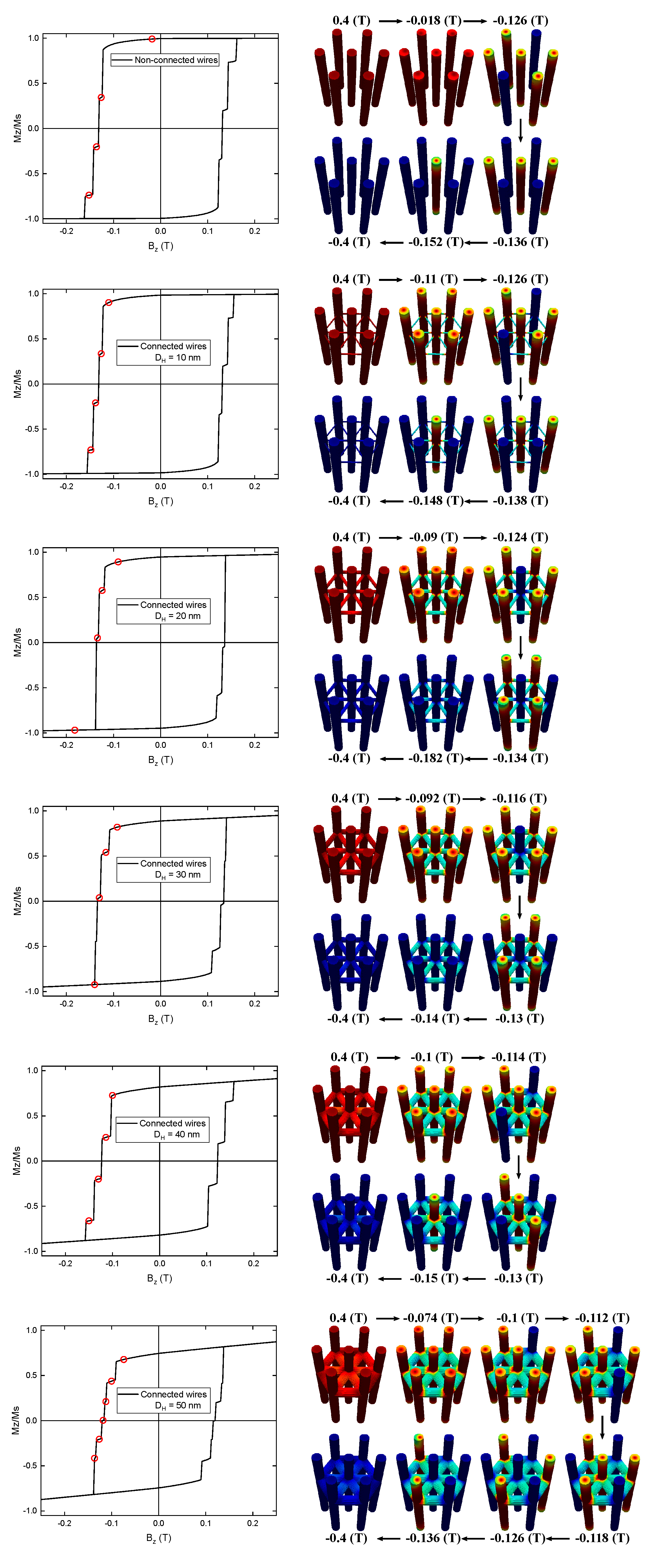
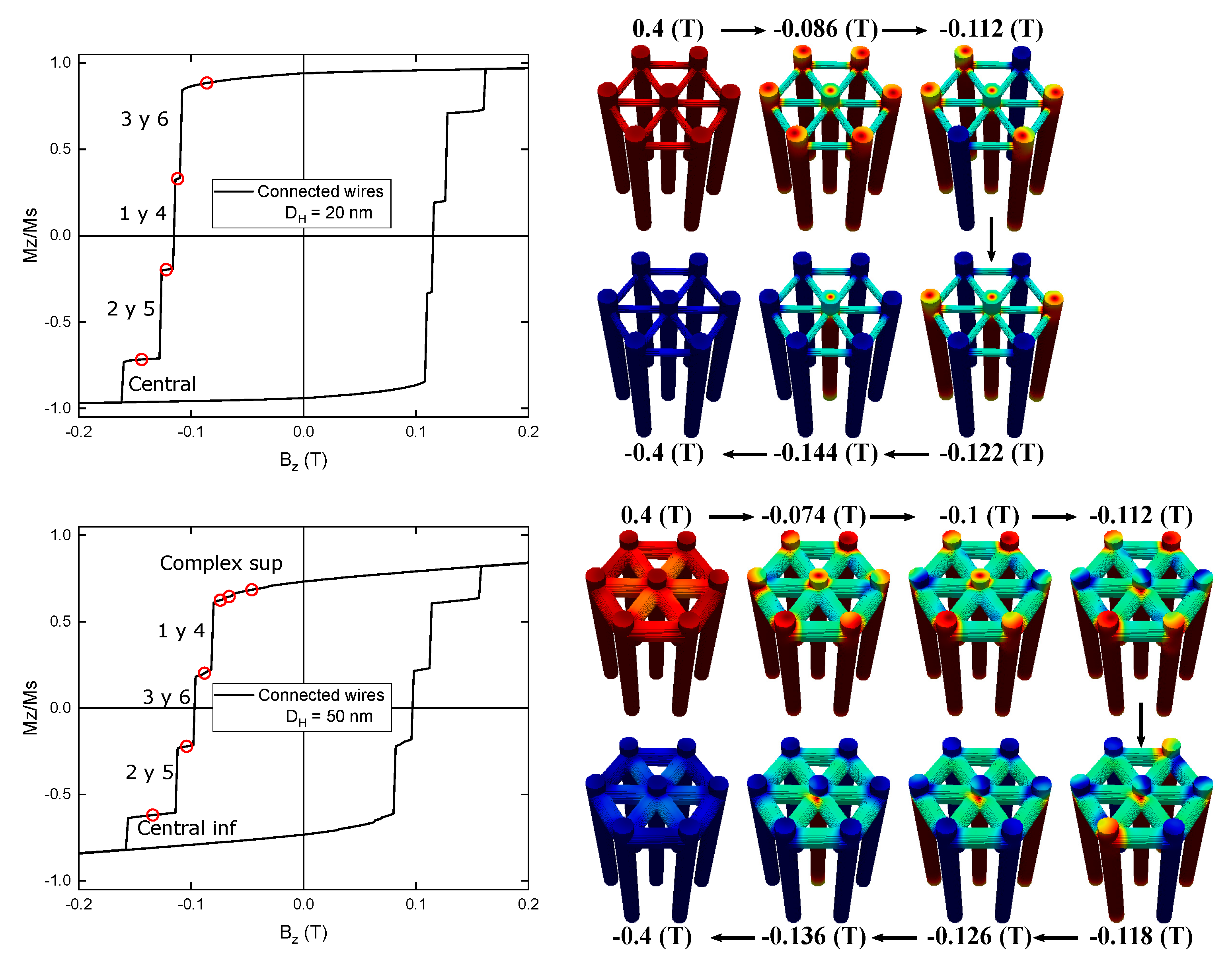
References
- Dastagir, T.; Xu, W.; Sinha, S.; Wu, H.; Cao, Y.; Yu, H. Tuning the permeability of permalloy films for on-chip inductor applications. Appl. Phys. Lett. 2010, 97, 162506. [Google Scholar] [CrossRef]
- Yin, Y.; Pan, F.; Ahlberg, M.; Ranjbar, M.; Durrenfeld, P.; Houshang, A.; Haidar, M.; Bregqvist, L.; Zhai, Y.; Dumas, R.K.; et al. Tunable permalloy-based films for magnonic devices. Phys. Rev. B 2015, 92, 024427. [Google Scholar] [CrossRef]
- Chen, T.-C.; Kuo, C.-Y.; Mishra, A.K.; Das, B.; Wu, J.-C. Magnetic domain wall motion in notch patterned permalloy nanowire devices. Phys. B Condens. Matter 2015, 476, 161. [Google Scholar] [CrossRef]
- Hayashi, M.; Thomas, L.; Rettner, C.; Moriya, R.; Parkin, S.S.P. Direct observation of the coherent precession of magnetic domain walls propagating along permalloy nanowires. Nat. Phys. 2007, 3, 21. [Google Scholar] [CrossRef] [Green Version]
- Arciniegas Jaimes, D.M.; Márquez, P.; Ovalle, A.; Escrig, J.; Linarez Pérez, O.; Bajales, N. Permalloy nanowires/Graphene oxide composite with enhanced conductive properties. Sci. Rep. 2020, 10, 13742. [Google Scholar] [CrossRef]
- Martín, J.; Martín-González, M.; Francisco Fernández, J.; Caballero-Calero, O. Ordered three-dimensional interconnected nanoarchitectures in anodic porous alumina. Nat. Commun. 2014, 5, 5130. [Google Scholar] [CrossRef] [Green Version]
- Zhu, M.; Yan, X.; Li, X.; Dai, L.; Guo, J.; Lei, Y.; Xu, Y.; Xu, H. Flexible, transparent, and hazy composite cellulosic film with interconnected silver nanowire networks for EMI shielding and Joule heating. ACS Appl. Mater. Interfaces 2022, 14, 45697. [Google Scholar] [CrossRef] [PubMed]
- Ruiz-Clavijo, A.; Caballero-Calero, O.; Manzano, C.V.; Maeder, X.; Beardo, A.; Caroixa, X.; Xavier Álvarez, F.; Martín-González, M. 3D Bi2Te3 interconnected nanowire networks to increase thermoelectric efficiency. ACS Appl. Energy Mater. 2021, 4, 13556. [Google Scholar] [CrossRef] [PubMed]
- Abreu Araujo, F.; Santa Clara Gomes, C.; Piraux, L. Magnetic control of flexible thermoelectric devices based on macroscopic 3D interconnected nanowire networks. Adv. Electron. Mater. 2019, 5, 1800819. [Google Scholar] [CrossRef] [Green Version]
- Santa Clara Gomes, T.C.; Marchal, N.; Abreu Araujo, F.; Piraux, L. Tunable magnetoresistance and thermopower in interconnected NiCr and CoCr nanowire networks. Appl. Phys. Lett. 2019, 115, 242402. [Google Scholar] [CrossRef]
- Santa Clara Gomes, T.C.; Marchal, N.; Abreu Araujo, F.; Piraux, L. Spin caloritronics in 3D interconnected nanowire networks. Nanomaterials 2020, 10, 2092. [Google Scholar] [CrossRef]
- Santa Clara Gomes, T.C.; Marchal, N.; Abreu Araujo, F.; Piraux, L. Magnetically activated flexible thermoelectric switches based on interconnected nanowire networks. Adv. Mater. Technol. 2022, 7, 2101043. [Google Scholar] [CrossRef]
- Santa Clara Gomes, T.C.; Marchal, N.; Abreu Araujo, F.; Piraux, L. Flexible thermoelectric films based on interconnected magnetic nanowire networks. J. Phys. D Appl. Phys. 2022, 55, 223001. [Google Scholar] [CrossRef]
- Marchal, N.; Santa Clara Gomes, T.C.; Abreu Araujo, F.; Piraux, L. Giant magnetoresistance and magneto-thermopower in 3D interconnected NixFe1−x/Cu multilayered nanowire networks. Nanomaterials 2021, 11, 1133. [Google Scholar] [CrossRef]
- Santa Clara Gomes, T.C.; de la Torre Medina, J.; Lemaitre, M.; Piraux, L. Magnetic and magnetoresistive properties of 3D interconnected NiCo nanowire networks. Nanoscale Res. Lett. 2016, 11, 466. [Google Scholar] [CrossRef] [PubMed] [Green Version]
- Santa Clara Gomes, T.C.; Marchal, N.; Abreu Araujo, F.; Velázquez Galván, Y.; de la Torre Medina, J.; Piraux, L. Magneto-transport in flexible 3D networks made of interconnected magnetic nanowires and nanotubes. Nanomaterials 2021, 11, 221. [Google Scholar] [CrossRef] [PubMed]
- Burks, E.C.; Gilbert, D.A.; Murray, P.D.; Flores, C.; Felter, T.E.; Charnvanichborikarn, S.; Kucheyev, S.O.; Colvin, J.D.; Yin, G.; Liu, K. 3D Nanomagnetism in low density interconnected nanowire networks. Nano Lett. 2021, 21, 716. [Google Scholar] [CrossRef] [PubMed]
- Bhattacharya, D.; Chen, Z.; Jensen, C.J.; Liu, C.; Burks, E.C.; Gilbert, D.A.; Zhang, X.; Yin, G.; Liu, K. 3D interconnected magnetic nanowire networks as potential integrated multistate memristors. Nano Lett. 2022, 22, 10010. [Google Scholar] [CrossRef]
- Omale, J.O.; Van Velthem, P.; Antohe, V.-A.; Vlad, A.; Piraux, L. Effects of electrolyte additives and nanowire diameter on the electrochemical performance of lithium-ion battery anodes based on interconnected nickel-tin nanowire networks. Energy Technol. 2021, 9, 2100062. [Google Scholar] [CrossRef]
- Kim, N.; Sahadeo, E.; Liu, C.; Rose, O.; Rubloff, G.; Bok Lee, S. Impact of pore size, interconnections, and dynamic conductivity on the electrochemistry of vanadium pentoxide in well defined porous structures. Phys. Chem. Chem. Phys. 2018, 20, 29708. [Google Scholar] [CrossRef]
- Omale, J.O.; Rupp, R.; Van Velthem, P.; Van Kerckhoven, V.; Antohe, V.-A.; Vlad, A.; Piraux, L. Three-dimensional microsupercapacitors based on interdigitated patterns of interconnected nanowire networks. Energy Storage Mater. 2019, 21, 77. [Google Scholar] [CrossRef]
- Zankowski, S.P.; Vereecken, P.M. Combining high porosity with high surface area in flexible interconnected nanowire meshes for hydrogen generation and beyond. ACS Appl. Mater. Interfaces 2018, 10, 44634. [Google Scholar] [CrossRef]
- Chen, Z.; Boyajian, N.; Lin, Z.; Yin, R.T.; Obaid, S.N.; Tian, J.; Brannan, J.A.; Chen, S.W.; Miniovich, A.N.; Lin, L.; et al. Flexible and transparent metal nanowire microelectrode arrays and interconnects for electrophysiology, optogenetics, and optical mapping. Adv. Mater. Technol. 2021, 6, 2100225. [Google Scholar] [CrossRef]
- Ruiz-Clavijo, A.; Ruiz-Gomez, S.; Caballero-Calero, O.; Pérez, L.; Martín-González, M. Tailoring magnetic anisotropy at Will in 3D interconnected nanowire networks. Phys. Status Solidi RRL 2019, 13, 1900263. [Google Scholar] [CrossRef]
- de la Torre Medina, J.; Santa Clara Gomes, T.C.; Velásquez Galván, Y.G.; Piraux, L. Large-scale 3-D interconnected Ni nanotube networks with controlled structural and magnetic properties. Sci. Rep. 2018, 8, 14555. [Google Scholar] [CrossRef] [PubMed] [Green Version]
- Santa Clara Gomes, T.C.; de la Torre Medina, J.; Velásquez-Galván, Y.G.; Martínez-Huerta, J.M.; Encinas, A.; Piraux, L. Interplay between the magnetic and magneto-transport properties of 3D interconnected nanowire networks. J. Appl. Phys. 2016, 120, 043904. [Google Scholar] [CrossRef]
- Ruiz-Clavijo, A.; Caballero-Calero, O.; Navas, D.; Ordoñez-Cencerrado, A.A.; Blanco-Portals, J.; Peiró, F.; Sanz, R.; Martín-González, M. Unveiling the complex magnetization reversal process in 3D nickel nanowire networks. Adv. Electron. Mater. 2022, 8, 2200342. [Google Scholar] [CrossRef]
- Manzano, C.V.; Rodríguez-Acevedo, J.; Caballero-Calero, O.; Martín-González, M. Interconnected three-dimensional anodized aluminum oxide (3D-AAO) metamaterials using different waveforms and metal layers for RGB display technology applications. J. Mater. Chem. C 2022, 10, 1787. [Google Scholar] [CrossRef]
- Ruiz-Clavijo, A.; Caballero-Calero, O.; Martín-González, M. Revisiting anodic alumina templates: From fabrication to applications. Nanoscale 2021, 13, 2227. [Google Scholar] [CrossRef]
- Hunt, M.; Taverne, M.; Askey, J.; May, A.; Van Den Berg, A.; Daniel Ho, Y.-L.; Rarity, J.; Ladak, S. Harnessing multi-photon absorption to produce three-dimensional magnetic structures at the nanoscale. Materials 2020, 13, 761. [Google Scholar] [CrossRef] [Green Version]
- Caballero-Calero, O.; Ruiz-Clavijo, A.; Manzano, C.V.; Martín-González, M.; Armelles, G. Plasmon resonances in 1D nanowire arrays and 3D nanowire networks of topological insulators and metals. Nanomaterials 2023, 13, 154. [Google Scholar] [CrossRef]
- Vansteenkiste, A.; Leliaert, J.; Dvornik, M.; Helsen, M.; García-Sánchez, F.; Van Waeyenberge, B. The design and verification of MuMax3. AIP Adv. 2014, 4, 107133. [Google Scholar] [CrossRef] [Green Version]
- Gilbert, T.L. A phenomenological theory of damping in ferromagnetic materials. IEEE Trans. Magn. 2004, 40, 3443. [Google Scholar] [CrossRef]
- Escrig, J.; Allende, S.; Altbir, D.; Bahiana, M. Magnetostatic interactions between magnetic nanotubes. Appl. Phys. Lett. 2008, 93, 023101. [Google Scholar] [CrossRef] [Green Version]
- Abo, G.S.; Hong, Y.; Choi, B.; Donahue, M.J.; Bae, S.; Jalli, J.; Park, J.; Lee, J.; Park, M.; Gee, S. Micromagnetic computer simulated scaling effect of s-shaped permalloy nano-element on operating fields for AND or OR logic. IEEE Trans. Magn. 2011, 48, 1851. [Google Scholar] [CrossRef] [Green Version]
- Sáez, G.; Cisternas, E.; Díaz, P.; Vogel, E.E.; Burr, J.P.; Saavedra, E.; Escrig, J. Tuning the coercive field by controlling the magnetization reversal processing permalloy modulated nanowires. J. Magn. Magn. Mater. 2020, 512, 1670451. [Google Scholar] [CrossRef]
- Kaffash, M.T.; Bang, W.; Lendinez, S.; Hoffmann, A.; Ketterson, J.B.; Jungfleisch, M.B. Control of spin dynamics in artificial honeycomb spin-ice based nanodisks. Phys. Rev. B 2020, 101, 174424. [Google Scholar] [CrossRef]
- Sáez, G.; Saavedra, E.; Vidal-Silva, N.; Escrig, J.; Vogel, E.E. Dynamic susceptibility of a Bloch point singularity confined in a magnetic nanowire. Results Phys. 2022, 37, 105530. [Google Scholar] [CrossRef]
- Fullerton, J.; Hierro-Rodríguez, A.; Donnelly, C.; Sanz-Hernández, D.; Skoric, L.; MacLaren, D.A.; Fernández-Pacheco, A. Controlled evolution of three-dimensional magnetic states in strongly coupled cylindrical nanowire pairs. Nanotechnology 2023, 34, 125301. [Google Scholar] [CrossRef]
- Sáez, G.; Díaz, P.; Cisternas, E.; Vogel, E.E.; Escrig, J. Information storage in permalloy modulated magnetic nanowires. Sci. Rep. 2021, 11, 20811. [Google Scholar] [CrossRef]
- Escrig, J.; Altbir, D.; Jaafar, M.; Navas, D.; Asenjo, A.; Vázquez, M. Remanence of Ni nanowire arrays: Influence of size and labyrinth magnetic structure. Phys. Rev. B 2007, 75, 184429. [Google Scholar] [CrossRef] [Green Version]
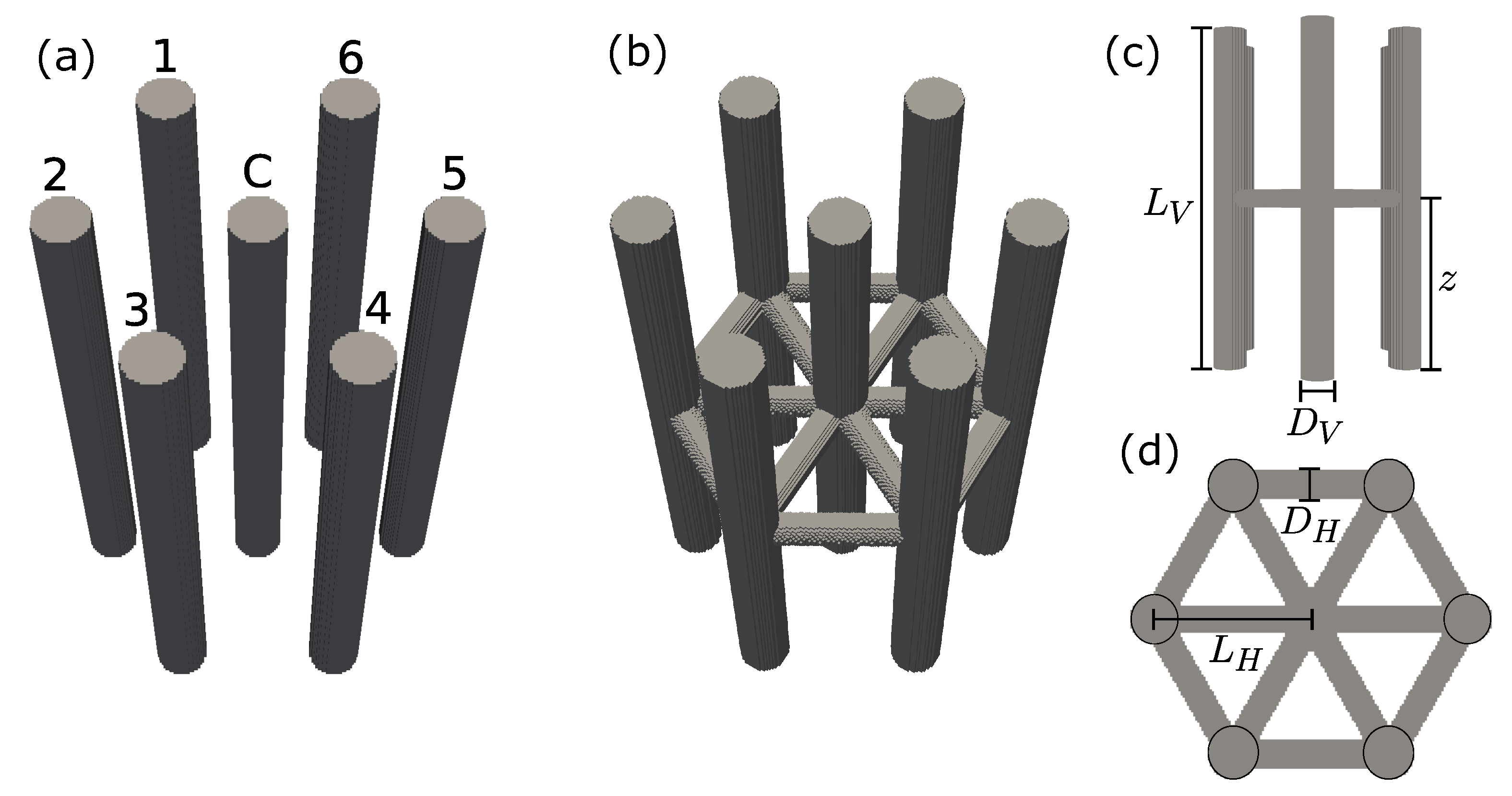
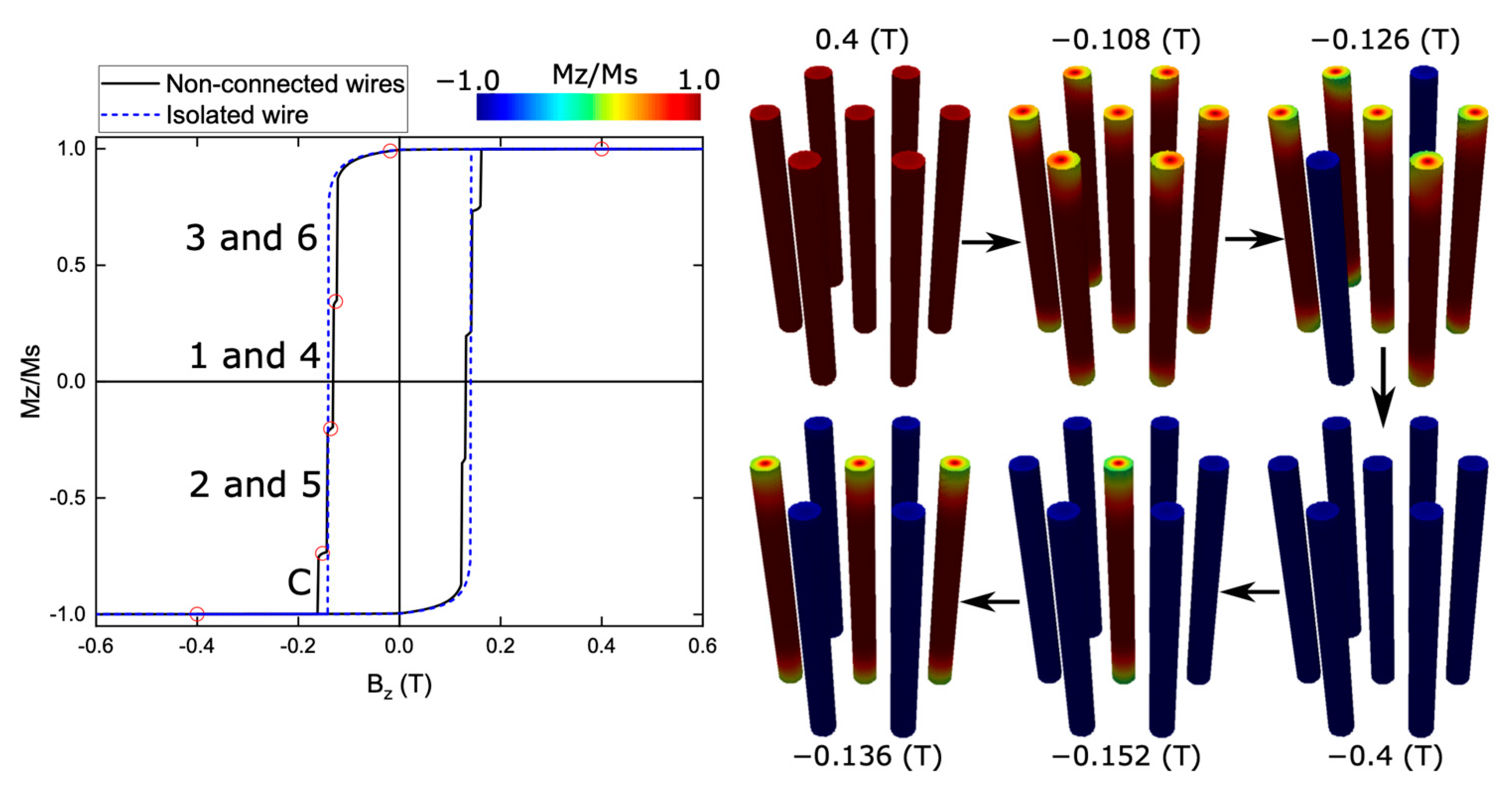
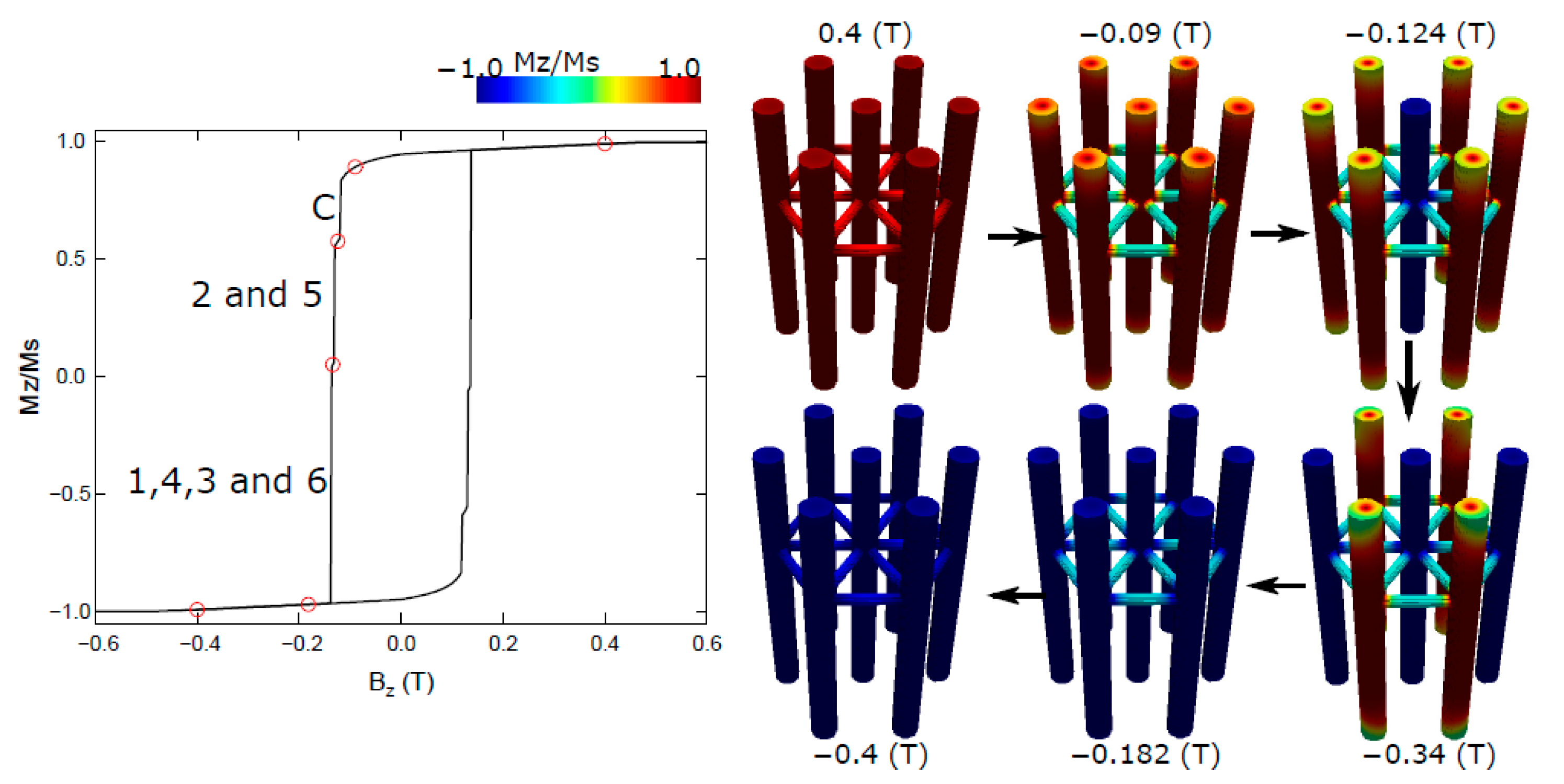


Disclaimer/Publisher’s Note: The statements, opinions and data contained in all publications are solely those of the individual author(s) and contributor(s) and not of MDPI and/or the editor(s). MDPI and/or the editor(s) disclaim responsibility for any injury to people or property resulting from any ideas, methods, instructions or products referred to in the content. |
© 2023 by the authors. Licensee MDPI, Basel, Switzerland. This article is an open access article distributed under the terms and conditions of the Creative Commons Attribution (CC BY) license (https://creativecommons.org/licenses/by/4.0/).
Share and Cite
Pereira, A.; Sáez, G.; Saavedra, E.; Escrig, J. Tunable Magnetic Properties of Interconnected Permalloy Nanowire Networks. Nanomaterials 2023, 13, 1971. https://doi.org/10.3390/nano13131971
Pereira A, Sáez G, Saavedra E, Escrig J. Tunable Magnetic Properties of Interconnected Permalloy Nanowire Networks. Nanomaterials. 2023; 13(13):1971. https://doi.org/10.3390/nano13131971
Chicago/Turabian StylePereira, Alejandro, Guidobeth Sáez, Eduardo Saavedra, and Juan Escrig. 2023. "Tunable Magnetic Properties of Interconnected Permalloy Nanowire Networks" Nanomaterials 13, no. 13: 1971. https://doi.org/10.3390/nano13131971
APA StylePereira, A., Sáez, G., Saavedra, E., & Escrig, J. (2023). Tunable Magnetic Properties of Interconnected Permalloy Nanowire Networks. Nanomaterials, 13(13), 1971. https://doi.org/10.3390/nano13131971






